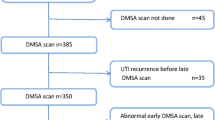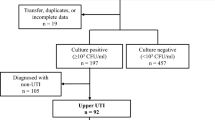Abstract
The purpose of the study was to compare bacterial species, clinical, laboratory and imaging findings (99m Tc-dimercaptosuccinic acid renal scan and voiding cystogram) in infants and children with high (≥105 colony forming units (CFU)/ml, group A patients) and low (≤5×104 CFU/ml, group C patients) bacterial count in urine cultures during first episode of urinary tract infection. Group B included patients with intermediate CFU/ml. Included were 419 symptomatic patients with: (a) no previous antibiotic treatment, (b) urine samples for quantitative cultures taken by bladder catheterisation or suprapubic bladder aspiration, (c) growth of only one microorganism, and (d) age ≤54 months (age of the oldest patient of group C). Out of 419 cultures, Escherichia coli grew in 315 (75.2%), gram-negative bacteria except E. coli in 91 (21.7%) and gram-positive in 13 (3.1%). Group C patients were significantly ( P <0.0001) more often affected with gram-negative pathogens except E. coli than group A patients (21/44 versus 67/360). Most of group C patients were younger than 24 months of age; none was older than 54 months. Comparison of the prevalence of clinical and laboratory (leucocyte count, CRP, ESR) findings between groups A and C showed no significant differences. There was no statistically significant difference in the prevalence of pyelonephritis, reflux and urological malformations (except reflux) between groups A and C. Conclusion: Low bacterial count urinary tract infections mainly affect infants and young children and are often due to gram-negative bacteria other than E. coli. Clinical and laboratory findings, prevalence of pyelonephritis, reflux and urological malformations are similar in high and low bacterial count urinary tract infections.
Similar content being viewed by others
Abbreviations
- CFU :
-
colony forming units
- HPF :
-
high-power field
- SPA :
-
suprapubic bladder aspiration
- 99m Tc-DMSA :
-
99m Tc-dimercaptosuccinic acid
- UTI :
-
urinary tract infection
- VCUG :
-
voiding cystourethrography
References
American Academy of Pediatrics (1999) Practice parameter: the diagnosis, treatment, and evaluation of the initial urinary tract infection in febrile infants and young children. Pediatrics 103: 843–848
Buys H, Pead L, Hallett R, Maskell R (1994) Suprapubic aspiration under ultrasound guidance in children with fever of undiagnosed cause. BMJ 308: 690–692
Fairley KF, Birch DF (1989) Detection of bladder bacteriuria in patients with acute urinary symptoms. J Infect Dis 159: 226–231
Gordon DM, Riley MA (1992) A theoretical and experimental analysis of bacterial growth in the bladder. Mol Microbiol 6: 555–562
Hansson S, Brandstrom P, Jodal U, Larsson P (1998) Low bacterial counts in infants with urinary tract infection. J Pediatr 132: 180–182
Hellerstein S (1982) Reccurent urinary tract infection in children. Pediatr Infect Dis 1: 271–281
Hellerstein S (1995) Urinary tract infections: old and new concepts. Pediatr Clin North Am 42: 1433–1457
Hoberman A, Wald ER (1997) Urinary tract infections in young febrile children. Pediatr Infect Dis J 16: 11–17
Hoberman A, Chao HP, Keller DM, Hickey R, Davis HW, Ellis D (1993) Prevalence of urinary tract infection in febrile infants. J Pediatr 123: 17–23
Hoberman A, Wald ER, Reynolds EA, Penchansky L, Charron M (1994) Pyuria and bacteriuria in urine specimens obtained by catheter from young children with fever. J Pediatr 124: 513–519
Hoberman A, Charron M, Hickey RW, Baskin M, Keaney DH, Wald ER (2003) Imaging studies after a first febrile urinary tract infection in young children. N Engl J Med 348: 195–202
Hull RA, Hull SI (1997) Nutritional requirements for growth of uropathogenic Escherichia coli in human urine. Infect Immun 65: 1960–1961
International Reflux Study Committee (1981) Medical versus surgical treatment of primary vesicoureteral reflux: report of the International Reflux Study Committee. Pediatrics 67: 392–400
International Reflux Study in Children. Writing Commitee: Lebowitz RL, Olbing H, Parkkulainen KV, Smellie JM, Tamminen-Moebius TE (1985) International system of radiographic grading of vesicoureteric reflux. Pediatr Radiol 15: 105–109
Kass EH (1956) Asymptomatic infection of urinary tract. Trans Assoc Am Physicians 69: 56–63
Kass EH (1957) Bacteriuria and the diagnosis of infection of the urinary tract. AMA Arch Intern Med 100: 709–714
Leffler H, Savnborg-Eden C (1981) Glycolipid receptors for uropathogenic E. coli binding to human erythrocytes and uroepithelial cells. Infect Immun 34: 920–929
Levtchenko EN, Lahy C, Levy J, Ham HR, Piepsz A (2001) Role of Tc99m DMSA scintigraphy in the diagnosis of culture negative pyelonephritis. Pediatr Nephrol 16: 503–506
Mabeck CE (1969) Studies in urinary tract infections. I. The diagnosis of bacteriuria in women. Acta Med Scand 186: 35–38
Marple CD (1941) The frequency and character of urinary tract infections in an unselected group of woman. Ann Intern Med 14: 220
Oelschlaeger TA, Dobrindt U, Hacker J (2002) Virulence factors of uropathogens. Curr Opin Urol 12: 33–38
Papanastasiou DA, Dimitracopoulos G, Drakou A, Haliotis F, Spiliopoulou I (1998) Significant bacteriuria in infants and young children and relation to bacterial species and pyuria. Clin Microbiol Infect 4: 284–287
Pead L, Maskell R (1994) Study of urinary tract infection in children in one health district. BMJ 309: 631–634
Piepsz A, Hahn K, Roca I, Ciofetta G, Toth G, Gordon I, Kolinska J, Gwidlet J (1990) A radiopharmaceuticals schedule for imaging in paediatrics. Paediatric Task Group European Association Nuclear Medicine. Eur J Nucl Med 17: 127–129
Pryles CV, Steg NL (1959) Specimens of urine obtained from young girls by catheter versus voiding. A comparative study of bacterial cultures, gram stains and bacterial counts in paired specimens. Pediatrics 23: 441–452
Pryles CV, Atkin MD, Morse TS, Welch KJ (1959) Comparative bacteriologic study of urine obtained from children by percutaneous suprapubic aspiration of the bladder and by catheter. Pediatrics 24: 983–991
Roberts KB, Charney E, Sweren RJ, Ahonkhai VI, Bergman DA, Coulter MP, Fendrick GM, Lachman BS, Lawless MR, Pantell RH, Stein MT (1983) Urinary tract infection in infants with unexplained fever: a collaborative study. J Pediatr 103: 864–867
Sanford JP, Favour CB, Mao FH, Harrison JH (1956) Evaluation of the “positive” urine culture: an approach to the differentiation of significant bacteria from contaminants. Am J Med 20: 88–93
Stamm WE, Counts GW, Running KR, Fihn S, Turck M, Holmes KK (1982) Diagnosis of coliform infection in acutely dysuric women. N Engl J Med 307: 463–468
Wiswell TE, Roscelli JD (1986) Corroborative evidence for the decreased incidence of urinary tract infections in circumcised male infants. Pediatrics 78: 96–99
Wullt B, Bergsten G, Samuelsson M, Svanborg C (2002) The role of P fimbriae for Escherichia coli establishment and mucosal inflammation in the human urinary tract. Int J Antimicrob Agents 19: 522–538
Zafriri D, Oron Y, Eisenstein BI, Ofek I (1987) Growth advantages and enhanced toxicity of E. coli adherent to tissue culture cells due to restricted diffusion of products secreted by the cells. J Clin Invest 79: 1210–1216
Author information
Authors and Affiliations
Corresponding author
Rights and permissions
About this article
Cite this article
Kanellopoulos, T.A., Vassilakos, P.J., Kantzis, M. et al. Low bacterial count urinary tract infections in infants and young children. Eur J Pediatr 164, 355–361 (2005). https://doi.org/10.1007/s00431-005-1632-0
Received:
Accepted:
Published:
Issue Date:
DOI: https://doi.org/10.1007/s00431-005-1632-0




